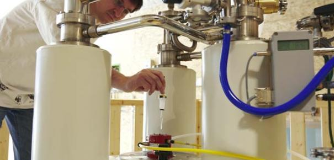Providing structural and dynamic information by measuring nuclear relaxation rates
Instruct has 0 centres offering Fast field cycling relaxometry across Europe. Navigate the map and click on the pins to discover centres near you.
Fast field cycling relaxometry is a tool for measuring nuclear relaxation rates from very low magnetic fields (0.01 MHz proton Larmor frequency) up to 1 T (about 45 MHz proton Larmor frequency). The field dependence of the relaxation rates provides information on the structural and dynamic features of the molecule (and, in the case of paramagnetic systems, on the electron relaxation).
Relaxometry measurements can be performed in water solutions on water protons. In this case, information can be obtained on the correlation times modulating the dipolar interactions between protons, and thus on the reorientation time and aggregation state of the system. Relaxometry measurements have been shown to be largely useful in determining the presence of binding between macromolecules or between a small paramagnetic complex and a macromolecule, as well as for studying the mechanisms responsible for electron relaxation. It is largely used for the characterization of contrast agents for magnetic resonance imaging (MRI) and for their optimization. Recently, it was successfully applied to the characterization of radicals for applications to dynamic nuclear polarization (DNP).
Relaxation profiles can also be measured by dissolving proteins in D2O at mM concentration. In this way the average relaxation rates of protein protons can be directly detected, so that information on internal mobility and protein aggregation, through a safe estimate of the reorientational time of the protein, can be obtained. These profiles are characterized by very large relaxation rate at low fields (100-5000 s-1), given by the product of the squared order parameter, the reorientational time and the average quadratic dipolar energy, and by a dispersion with correlation time given by the reorientational time of the protein. Unfolded proteins are characterized by a small order parameter, and consequently by a small relaxation rate also at low fields (10-50 s-1).

